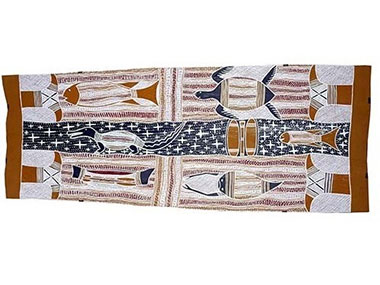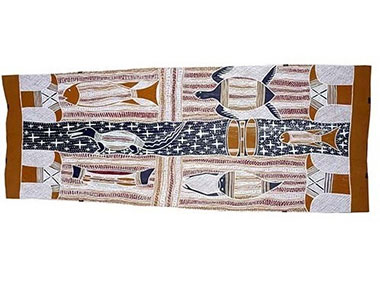Gapu-Monuk – Saltwater Barks

'Milngiyawuy' Maymuru showing the mortuary rituals of the Manggalili clan. With sacred clouds at either end, the centre shows the Milngiya River transforming into the Milky Way
Posted by Jeremy Eccles | 20.02.18
Gallery: Australian National Maritime Museum
Dates:
09.11.17
: 10.02.19
And this exhibition clearly counters the expected truth that it's only urban/Blak artists that are invariably political, while their remote cousins are “merely decorative”. This show of 40 Yirrkala bark paintings is 100% politics – and looks beautiful too. These are the people, after all, who created the Yirrkala Church Panels and the Bark Petition to the Parliament in Canberra.
In 1997, the Madarrpa clan leader Djambawa Marawili AM discovered an illegal poacher’s camp on his land that included a decapitated crocodile. It may have just been a wild animal. But the setting just happened to be the mythic nest of the Madarrpa's sacred crocodile totem, Baru. Forty-seven Yolŋu artists from fifteen clans and eighteen homeland communities in North-East Arnhem Land responded by revealing their sacred lore and their connections to land and sea through the patterns or designs known as Miny’tji in these substantial paintings, which have become known as the 'Saltwater Collection'.
More than a decade later, in July 2008, the High Court of Australia confirmed that the traditional owners of the Blue Mud Bay region in North-East Arnhem Land, together with the traditional owners of almost the entire Northern Territory coastline, have exclusive access rights to tidal waters overlying Aboriginal land. And their paintings were deemed the legal equivalent of title deeds to the sea rights of coastal waters.
The exhibition originally toured Canberra, Perth, Sydney, Melbourne and Alice Springs in 1999/2000 – leading to the Maritime Museum buying the Collection. Now they've added Mokuy (spirit) carvings, Larrakitj (mortuary pole paintings on hollowed trees) and other traditional and contemporary works. Oral histories on film and aerial photography help visitors delve deeper into the stories of the communities who created the paintings, revealing a richer understanding of their connection to sea country.
And one of the riches revealed is the Yolngu's understanding of the complex relationship between fresh and saltwater, and the vitality – both ecological and spiritual at the point were the two meet. Concepts represented in ochres include fertility, Baru's breeding ground and its links to the ancestral fire, the importance of sea-grass, the muddied waters where the Ancestral Shark thrashes its tail, the rock where Barul'tji the lightning snake tastes the beginning of the wet season and spits lightning into the sky, the sacred cycle of the sea evaporating and becoming clouds, souls rising further into the Milky Way.... “It's like a university”, says Djambawa Marawili in a video about the accumulation of ancestral knowledge that forms one level of the barks' visual library.
And the way the barks are laid out allows some sense of the priorities and design sense of different communities to emerge. Sadly, fourteen of the original artists have died since 1997, including such artistic leaders as Gawirrin Gumana, Boliny Wanambi, Gaymala Yunupingu and Dr Raymattja Marika. Survivors include Banduk Marika, Nonggirrnga Marawili, Naminapu Maymuru-White and Rerrkirrwanga Mununggurr.
And the original catalogue has been updated with details of the Blue Mud Bay case that delivered the Yolngu their sea-rights.
URL: http://www.anmm.gov.au/whats-on/exhibitions/on-now/saltwater
Share this:
»  del.icio.us
»
del.icio.us
»  Digg it
»
Digg it
»  reddit
»
reddit
»  Google
»
Google
»  StumbleUpon
»
StumbleUpon
»  Technorati
»
Technorati
»  Facebook
Facebook
Contact Details
Gallery: Australian National Maritime Museum
Telephone: +61 2 9298 3777
Address: 2 Murray Street Darling Harbour Sydney 2009 NSW
Gallery: Australian National Maritime Museum
Telephone: +61 2 9298 3777
Address: 2 Murray Street Darling Harbour Sydney 2009 NSW

Djambawa Marawili's 'Contemporary Madarrpa' showing the hunt for stingrays at his Baniyala homeland with its links to the Macassans who visited every year for centuries

This bark show's Miniyawany Yunupingu's view of the sea from his camp at Caledon Bay, a place where fresh and seawater mix. Baru appears at the centre
Where is the exhibition?
Further Research
Gallery: Australian National Maritime Museum
Artists: Banduk Marika | Boliny Wanambi | Djambawa Marawili | Dr Raymattja Marika | Gawirrin Gumana | Gaymala Yunupingu | Naminapu Maymuru-White | Nonggirrnga Marawili | Rerrkirrwanga Mununggurr
News Tags: Aboriginal sea rights | Baru | Blue Mud Bay Case | Jeremy Eccles | National Maritime Museum | Saltwater Collection | scared crocodile
News Categories: Australia | Blog | Exhibition | Feature | Industry | News
Exhibition Archive
- 20.02.18 | Gapu-Monuk – Saltwater Barks
- 16.02.18 | SONGLINES SYMPOSIUM
- 06.02.18 | SONGLINES – TRACKING THE SEVEN SISTERS
- 31.01.18 | Dennis Nona Emerges in Hobart
- 30.11.17 | Great Artists, Great Stories, Limited Time
- 27.11.17 | Moodoonuthi - 'Little One'
- 24.11.17 | 20% Off until End November
- 23.11.17 | THE APY LANDS COME TO SYDNEY
- 14.11.17 | Entries Open for 2018 NATSIAAs
- 01.11.17 | PAINTING COUNTRY
- 23.10.17 | The Scholls Donate Half their Art
- 10.10.17 | TARNANTHI 2017
- 11.08.17 | Natsiaas 2017
- 20.07.17 | APY ART DOMINATES THE WYNNE
- 17.07.17 | Anangu Artist Wins $100,000 Prize
Advertising

